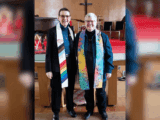Julian Brave NoiceCat is seated in a softly lit room, framed by white-panelled walls and dark wooden beams. At 32, he is an award-winning writer and filmmaker, a champion powwow dancer and a member of the Canim Lake Band (Tsq’éscen’) and Secwépemc Nation, descended as well from the Líl’wat Nation of Mount Currie.
His long hair falls loose over his shoulders, and with each movement, a pair of pāua shell earrings catches the light, a gift from a Māori host, traded for paddle earrings carved by his father. He wears a sleeveless black vest over a white tee. A flight awaits him in a few hours, but he doesn’t seem rushed.
You may unsubscribe from any of our newsletters at any time.
There’s something calm and deliberate in how he holds himself throughout our Zoom conversation from his writing desk at home in Bremerton, Wash. He often glances upward, pausing to consider each answer before the words tumble out. He lets silence do some of the work, but also knows when to break it, dropping a joke or punchline mid-thought.
“It’s a story about genocide,” NoiseCat says before pausing, then smirks. “But it’s also a buddy stoner road trip comedy with me and my dad.”
He’s talking about Sugarcane, his debut documentary co-directed with Emily Kassie, which won the U.S. Documentary Directing Award at the 2024 Sundance Film Festival and was nominated for best documentary feature at the 97th Academy Awards, making NoiseCat the first North American Indigenous filmmaker ever nominated in this category at the Oscars. But this film is more than a work of history. It hints at a much older storytelling tradition: Coyote stories.
Before the priests and the schools, before the anthropologists arrived to write things down, there were Coyote stories. Told in the winter, in the glow of the fire, moving from house to house like weather, these Salish stories are shapeshifting narratives that teach through contradiction, humour and reversal, never arriving at answers but circling them instead. Colonialism tried to erase them, but like Coyote himself, the stories refuse to die. Instead, they take on different forms, sometimes appearing as a documentary, a book or even a joke slipped into the middle of an interview.
Coyote is celebrated as a Creator and a trickster, at once humorous, unruly and cunning, shaping the world through mischief as much as through care. For the people who carry Coyote stories, they are not make-believe. They are a memory of what was seen and known, carried forward with each new generation. NoiseCat positions himself within this trickster lineage, braiding personal lexéy’em (oral histories) with mythic tspetékwll (origin stories) to reflect on land, kinship and inheritance. He resists clean redemption arcs in favour of messier truths, allowing Indigenous storywork to do what it has always done: remember, unsettle and laugh in the face of hardship.
“[Telling true stories] is one of the oldest and most important roles in our community life and our society,” NoiseCat says. “It’s one that’s deeply under threat right now, and I want to do it to the best of my ability, in a way that’s part of a broader effort all of our people are engaged in, an effort to reclaim who we are and our rightful place in this world. So much was taken away. And I hope my work contributes to our memory. I think we all do.”
Long before he was known as a writer or filmmaker, NoiseCat was a champion powwow dancer, a hockey player with big-league dreams and a kid who learned about his people by watching 500 Nations on a well-worn VHS, even if it meant getting Indigenous history from Kevin Costner.
Raised by his white mother, Alex Roddy, after his father left when he was young, NoiseCat was born in Minnesota and grew up in Oakland, Calif. His mother kept him connected to his Secwépemc and Líl’wat roots through Christmas holiday trips to Canim Lake, B.C. She also took him to the Intertribal Friendship House in Oakland, beaded regalia for his powwows and filled his shelves with books by Indigenous authors. “I wrote Sherman Alexie fan fiction set on the rez when I was 12,” he says, still laughing at the memory of trying to emulate the popular Spokane novelist.
Later, NoiseCat was a student of history, first at Columbia University and then at Oxford, always reading and asking questions. Along the way, he wrestled with the feeling of being “half white and not Indian enough.” In Sugarcane, he recalls trying to cut a fish efficiently and realizing how far his skills fell from those of his grandfather, who could make or fix anything. “I’d be kind of good for nothing in certain ways,” he tells me with a laugh.
His curiosity pulled him in many other directions. After Oxford, he spent time in New York City working on affordable housing policy, then moved into climate action with 350.org and later into political strategy with Data for Progress. He even helped lead a canoe journey around Alcatraz in 2019 to mark the 50th anniversary of the island’s 1969 occupation by Indians of All Tribes, carrying the story of that 19-month protest back onto the water. Not long after, his attention turned to politics.
“One of the biggest tricks I ever pulled on the white man was coming up with the idea that Deb Haaland should be secretary of the interior,” he says of the Laguna Pueblo politician, grinning at the memory. At the time, he was living in Washington, D.C. The idea began as a joke, half-serious. “I was in a unique position — both a journalist and a bit of an advocate,” he says.
While working at a think-tank, he added Haaland’s name to a “pie in the sky” list of potential progressive cabinet nominees, where she would go on to become the first Native American to serve as a U.S. cabinet secretary. “She was not the insider pick, but sometimes the trickster wins,” he says.
That same mix of observation, timing and instinct for story carried him deeper into journalism. Over the years, he has published stories that range from an essay on the power of Native voices in the U.S. cabinet for Politico, to a piece on the geography of belonging for The Paris Review, to an examination of the urgency of cultural erasure for The Nation. He spoke with Standing Rock activists for Rolling Stone, examined the future of Indigenous masculinity for National Geographic and traced Alcatraz’s continuing weight in Native American memory for the New York Times.
His dedication to telling true stories has carried him into his current work: the Sundance-winning Sugarcane and his debut book, We Survived the Night, released in October. Both stretch his storytelling into longform, holding investigative reporting alongside lived Indigenous histories, his own included.
More on Broadview:
- Leah Gazan on why Canada should outlaw residential school denialism
- How Qualicum First Nation woke up its language
- What if Elon Musk becomes a trillionaire?
The genesis of Sugarcane traces back to the 2021 revelations of unmarked graves at former residential “schools” across Canada. Emily Kassie, an investigative journalist, reached out to NoiseCat to collaborate, and together they turned their attention to St. Joseph’s Mission, a residential institution operated by the Catholic Church in Williams Lake, B.C., where his father, Ed Archie, was born.
The film begins on the road: Julian in the driver’s seat, visor down, heading toward Williams Lake. The town, known today for its stampede and ranch culture, sits along the old Cariboo Gold Rush trail, a place where colonial and cowboy mythologies still echo. Just east of the town lies Sugarcane Reserve, home to the Williams Lake First Nation. A short drive beyond that sits the former St. Joseph’s Mission Residential School.
As Julian makes his way toward Sugarcane Reserve, the film winks at the western genre, trading cowboys for cousins and showdowns for difficult conversations. Ed appears in fragments, carving wood in a sunlit shop, a cedar hat shadowing his face, hands weathered and worn. Then Julian is on a hill, alone, looking out over St. Joseph’s Mission Residential School. It’s his dad’s birthday. He calls him.
What follows are several interwoven stories that reveal details about infanticides and other abuses at the institution. But that’s not the only story. There’s also the road and everything it makes space for. In the Coyote tradition, healing and laughter emerge in the small moments: gas station snacks, Neil Young singalongs, jokes about wet T-shirt contests, and Ed, laughing while striking a pose in cut-off jean shorts and a cedar hat in front of a gas station pump. “You’re no longer a boy, son,” Ed says at one point. Julian quips back, “You’re a man now.” They both laugh and dive into stormy waters together (literally).
If anything, this is a film that demonstrates the enduring vitality of Coyote, known as Sk’elep in Secwépemc. What better way to trace an unfinished story than a road trip back to the rez and the mission where Ed was born, where both father and son, the abandoner and the abandoned, sit beside each other in motion?
NoiseCat’s book, We Survived the Night, arrives on the heels of Sugarcane’s Sundance win. Back in May, when I asked what the book was about, NoiseCat dodged with a smirk. “I would say people should read the book,” he offered. In a later email, he describes it as “a story about what it is to be Indigenous to Canada and the United States, beginning with the personal and expanding outward into a continent-wide portrait of Indigenous life.” It’s also, to his knowledge, “the first work of nonfiction ever written in the tradition of a Coyote Story.”
Now that the film has premiered and the book is out in the world, NoiseCat finds himself in a new kind of in-between. The pace has slowed, but like Coyote, NoiseCat keeps moving. On his desk, new projects, proposals and potential collaborations are taking shape. “I have a lot of clarity about what I want to do, which feels really good,” he says. “The most anxiety comes from the moments when you’re not sure what the story is that you want to tell, or how to tell it.”
“I think storytelling is intellectually, emotionally and spiritually demanding,” he shares. “You’re not supposed to prepare food for people if you have ill intentions. And I feel similarly about writing and telling stories. To do it right, you have to be in the right place yourself. So I orient a lot of my not-working time around how I can be my best self for my working time.”
NoiseCat talks about Coyote not as a metaphor to be neatly explained but as a living presence in his work and life. “Jesus died and was resurrected once,” he tells me with the hint of a smile. “Coyote died and was resurrected so many times we never even bothered to count.”
And that’s the point. For a people colonization tried to erase, the trickster endures, an undying figure for an undying people. “At the end times, there was a tradition that said Coyote was going to come back and that he was going to be part of our ancestors and our way of life coming back,” he adds. “And I think, at least poetically, maybe that’s what’s happening right now.”
***
This article first appeared in Broadview’s November/December 2025 issue with the title “Julian Brave NoiseCat walks with Coyote.”
Kayla MacInnis is a Métis storyteller from the Prairies, now living on Coast Salish territory. She is pursuing her master’s in English at Simon Fraser University.















